Cross-banded mushroom beetle
| Cross-banded mushroom beetle | ||||||||||||
|---|---|---|---|---|---|---|---|---|---|---|---|---|

Cross-banded mushroom beetle ( Mycetina cruciata ) on tree sponge with two short-winged birds |
||||||||||||
| Systematics | ||||||||||||
|
||||||||||||
| Scientific name | ||||||||||||
| Mycetina cruciata | ||||||||||||
| ( Schaller , 1783) |
 
|
|
|
Fig. 1: Top view, right copy with complete cross pattern |
|

|

|
| Fig. 2: from the front | Fig. 3: side view |
The cruciform mushroom beetle ( Mycetina cruciata , originally described as Chrysomela cruciata ) is a beetle from the family of the stubber beetle .
features
Cross-banded mushroom beetles are 3.8 to 4.5 millimeters long. The antennae and legs are black, while the pronotum and the elytra are orange to red in color. The beetle owes its name to a black cross drawing on the wing covers (Fig. 1 right). Often the crossbar of the cross is dissolved, the beetle is then black along the seam and has a black spot on each wing cover (other images).
The feelers are structured, the 9th element of the sensor being conical in shape. The two end links have the greatest width. The male beetles have an additional 6th ventral segment .
Other beetles also have a similar coloration and cross-markings, including the four-spotted tree sponge beetle ( Mycetophagus quadripustulatus ) from the tree sponge beetle family , which, however, has a reddish head and reddish legs, and Mycetophagus quadriguttatus , which also has reddish legs, has a more indistinct pattern the wing covers. From the family of black beetles , the yellow-banded black beetle ( Diaperis boleti ) has a black band on its yellow to dark orange-colored elytra, but is significantly larger. In the scarlet stub beetle ( Endomychus coccineus ) from the same family as the cruciform mushroom beetle, the black markings are in point and not in cross form.
The larvae also feed on mushrooms. They are brown in color. The segmented ridge has lobe-like outgrowths on the edges of the segments. A light dorsalomedian line runs from front to back . The larvae are similar to those of the stub beetle Aphorista vittata , which is only found in the United States .
Occurrence and way of life
Cross-banded mushroom beetles prefer to live in hilly to montane regions up to an altitude of 1350 meters. Their distribution area extends over Europe (except in the extreme north) and the Caucasus.
They can be found from April to September mostly on the underside of lying hardwood and coniferous trees, which are permeated by fungal mycelia , there often together with the barn beetle Scaphidium quadrimaculatum . Among the fungi, of which cross-banded fungus beetles feed, for example belonging Reihige Tramete ( Antrodia serialis ) Zunderschwamm ( Fomes fomentarius ), the Rotrandige Baumschwamm ( Fomitopsis pinicola ), the surface Lackporling ( Ganoderma applanatum ), the Common root sponge ( Heterobasidion annosum ), the fir fire sponge ( Phellinus hartigii ) and the butterfly tramete ( Trametes versicolor ).
literature
- Georg Möller, Reiner Grube, Ekkehard Wachmann : The Fauna Beetle Leader. Volume 1: Beetles in and around the forest. Fauna Verlag, Nottuln 2006, ISBN 3-935980-15-9 , p. 138.
Web links
- Profile of the cross-banded mushroom beetle on insektenbox.de
- Mycetina cruciata at Fauna Europaea. Retrieved April 15, 2020
- Mycetina cruciata at the National Center for Biotechnology Information (NCBI)
Individual evidence
- ↑ A photograph of larvae on BioLib.cz (English)
- ↑ Bolesław Burakowski: Descriptions of larva and pupa of Mycetina cruciata . Annales zoologici 47, 1997. (English)
- ↑ Entry of the cross-banded mushroom beetle on zipcodezoo.com ( Memento from February 9, 2013 in the web archive archive.today ), there up to 1361 meters (English)
- ↑ The cross-banded mushroom beetle on entomologie-stuttgart.de (archive version from December 26, 2015)